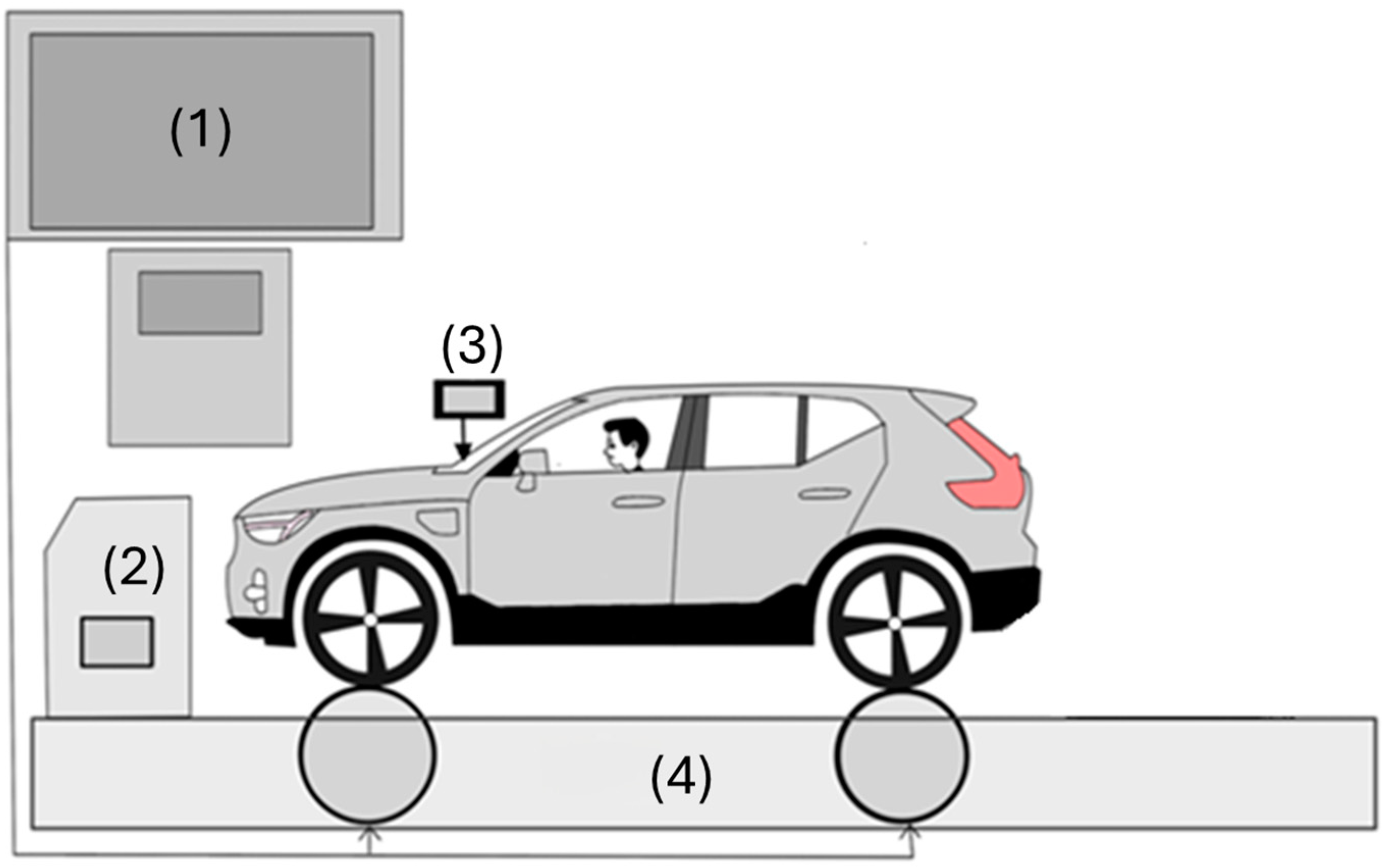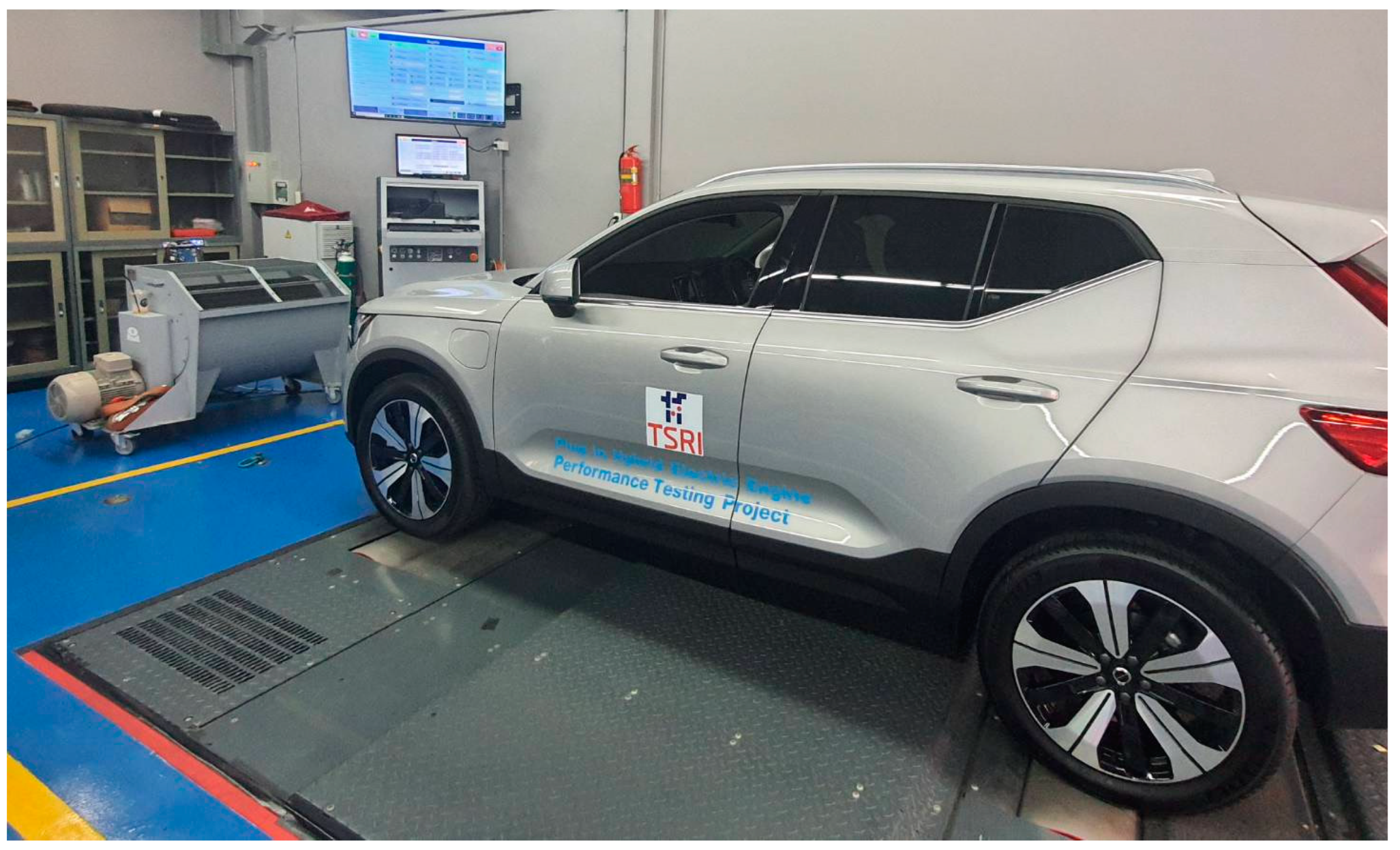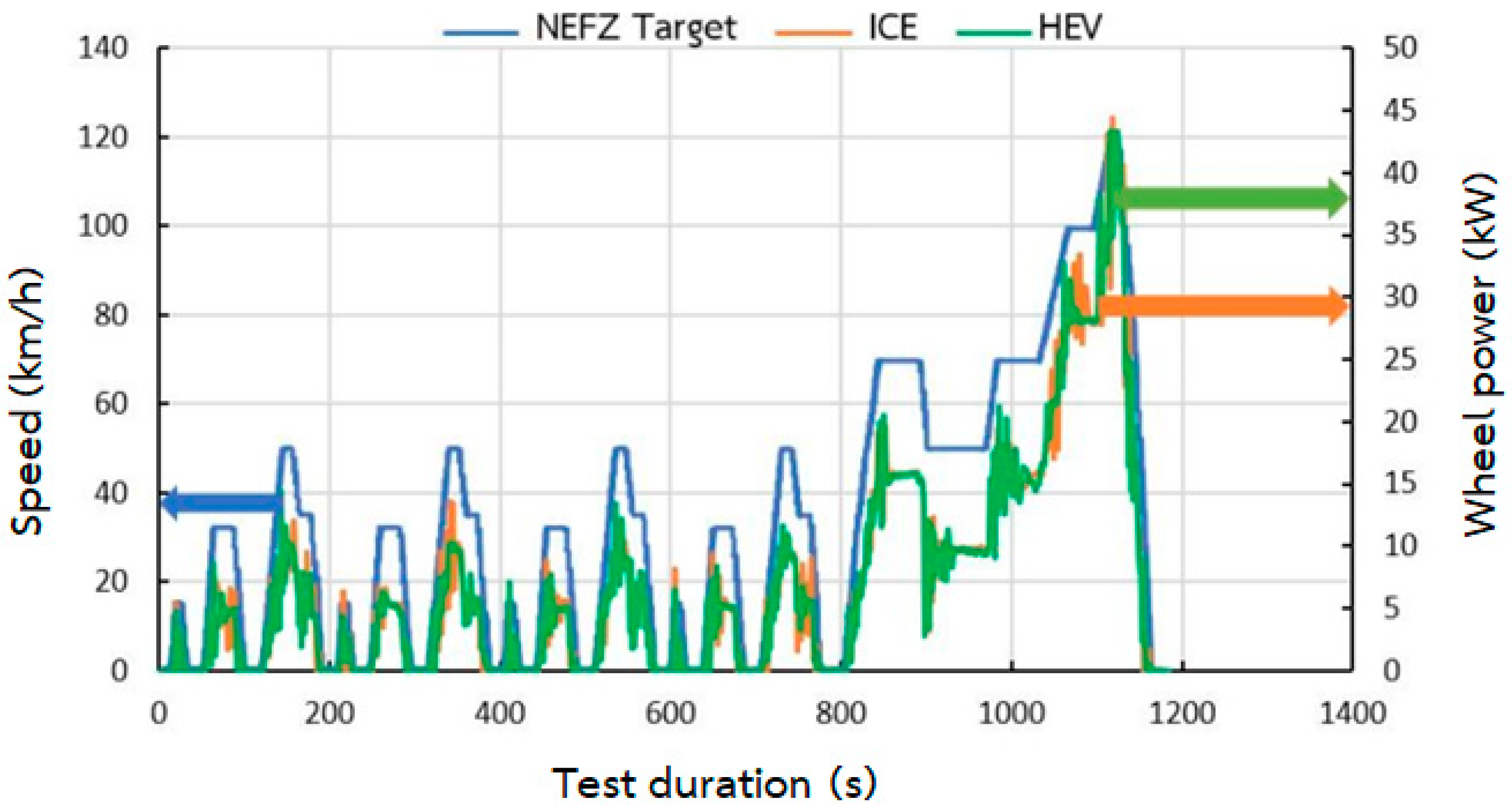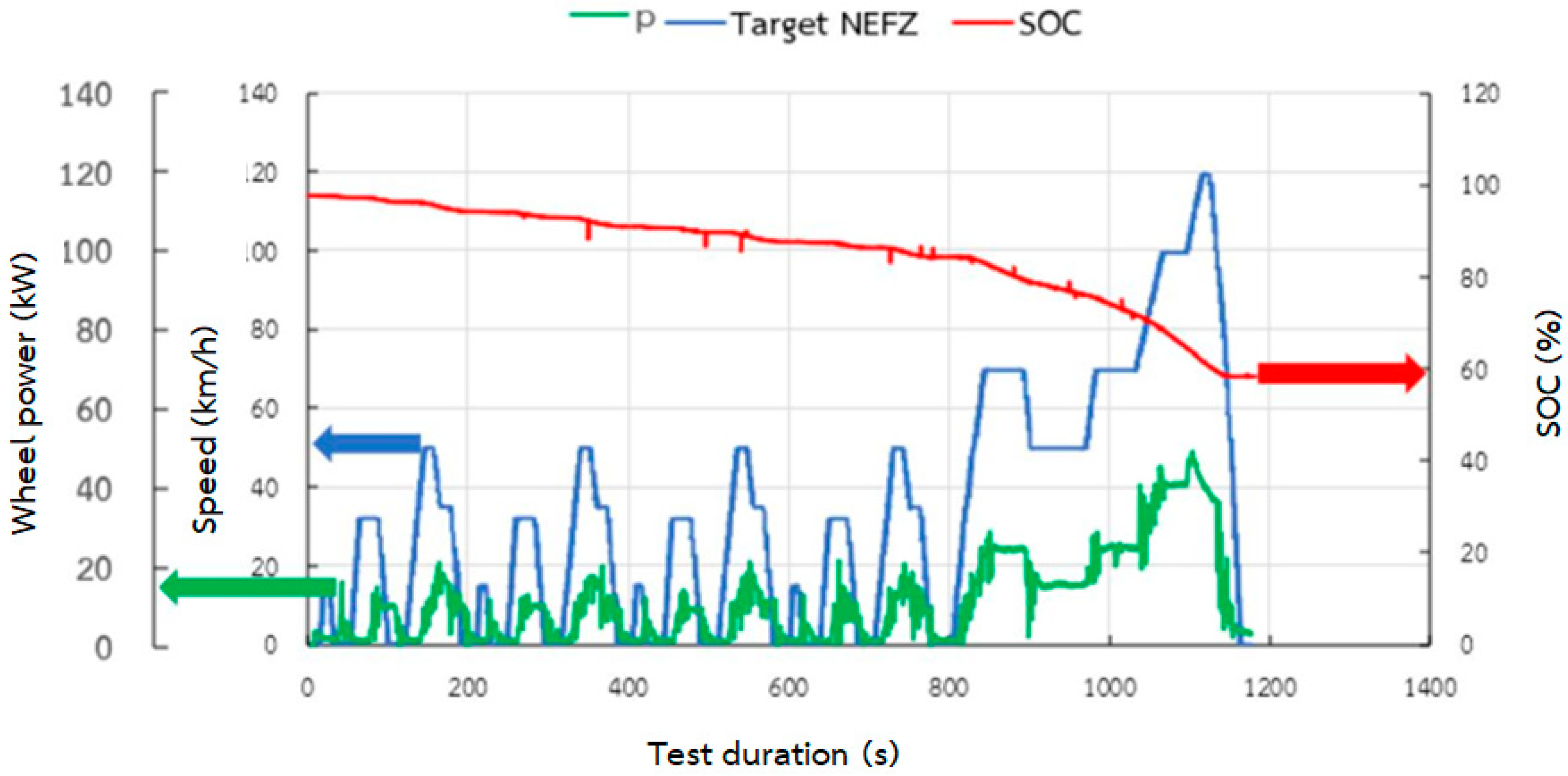Investigation of the Wheel Power and State of Charge of Plug-In Hybrid Electric Vehicles (PHEVs) on a Chassis Dynamometer in Various Driving Test Cycles
Abstract
1. Introduction
2. Research Methodology
2.1. Experimental Tools
2.2. Experimental Setup and Test Conditions
Dynamometer Configuration
3. Results and Discussion
3.1. US06 Driving Cycle
3.2. NEDC
3.3. EPA Highway Driving Cycle
4. Conclusions
4.1. The Driver Usage Pattern Maximizes EV Mode in Urban Settings
4.2. Key Findings
4.3. Limitations of This Study
Author Contributions
Funding
Institutional Review Board Statement
Informed Consent Statement
Data Availability Statement
Conflicts of Interest
Abbreviations
| s | Seconds |
| SOC | State of charge |
| PHEV | Plug-in hybrid electric vehicle |
| OBD | On-board diagnostics |
| ICE | Internal combustion engine |
| HEV | Hybrid mode power |
| RL | Reinforcement learning |
| CD | Charge-depleting mode |
References
- Bradley, T.H.; Frank, A.A. Design, Demonstrations and Sustainability Impact Assessments for Plug-in Hybrid Electric Vehicles. Renew. Sustain. Energy Rev. 2009, 13, 115–128. [Google Scholar] [CrossRef]
- Samaras, C.; Meisterling, K. Life Cycle Assessment of Greenhouse Gas Emissions from Plug-in Hybrid Vehicles: Implications for Policy. Environ. Sci. Technol. 2008, 42, 3170–3176. [Google Scholar] [CrossRef] [PubMed]
- Ching-Shin, N.S.; Constantine, S.; Richard, H.; Jeremy, J.M. Impact of Battery Weight and Charging Patterns on the Economic and Environmental Benefits of Plug-in Hybrid Vehicles. Energy Policy 2009, 37, 2653–2663. [Google Scholar] [CrossRef]
- SAE International. SAE J1711™—Recommended Practice for Measuring the Exhaust Emissions and Fuel Economy of Hybrid-Electric Vehicles, Including Plug-in Hybrid Vehicles; SAE International: Warrendale, PA, USA, 2023. [Google Scholar]
- Liu, X.; Zhao, F.; Hao, H.; Chen, K.; Liu, Z.; Babiker, H.; Amer, A.A. From NEDC to WLTP: Effect on the Energy Consumption, NEV Credits, and Subsidies Policies of PHEV in the Chinese Market. Sustainability 2020, 12, 5747. [Google Scholar] [CrossRef]
- Chen, Z.; Hu, H.; Wu, Y.; Xiao, R.; Shen, J.; Liu, Y. Energy Management for a Power-Split Plug-In Hybrid Electric Vehicle Based on Reinforcement Learning. Appl. Sci. 2018, 8, 2494. [Google Scholar] [CrossRef]
- Xiao, R.; Liu, B.; Shen, J.; Guo, N.; Yan, W.; Chen, Z. Comparisons of Energy Management Methods for a Parallel Plug-In Hybrid Electric Vehicle between the Convex Optimization and Dynamic Programming. Appl. Sci. 2018, 8, 218. [Google Scholar] [CrossRef]
- Chaisuwan, K. Real-World Energy Consumption of Plug-in Hybrid Electric Vehicle Adoption Scenario in Bangkok. Master’s Thesis, Chulalongkorn University, Bangkok, Thailand, 2017. [Google Scholar]
- Ehrenberger, S.I.; Konrad, M.; Philipps, F. Pollutant Emissions Analysis of Three Plug-in Hybrid Electric Vehicles Using Different Modes of Operation and Driving Conditions. Atmos. Environ. 2020, 234, 117612. [Google Scholar] [CrossRef]
- Duoba, M. HEV, PHEV, EV Test Standard Development and Validation. Available online: https://www.energy.gov (accessed on 10 September 2023).
- Navius, A.T.; Rooney, T.R. Improved PHEV Emission Measurements in a Chassis Dynamometer Test Cell. SAE Int. J. Engines 2013, 3, 1113–1123. [Google Scholar] [CrossRef]
- Li, X.; Zhou, Z.; Wei, C.; Gao, X.; Zhang, Y. Multi-objective optimization of hybrid electric vehicles energy management using multi-agent deep reinforcement learning framework. Energy AI 2025, 20, 100491. [Google Scholar] [CrossRef]
- Lu, L.; Zhao, H.; Xv, F.; Luo, Y.; Chen, J.; Ding, X. GA-LSTM speed prediction-based DDQN energy management for extended-range vehicles. Energy AI 2024, 17, 100367. [Google Scholar] [CrossRef]
- Dynamometer Drive Schedules, U.S. Environmental Protection Agency. Available online: https://www.epa.gov/vehicle-and-fuel-emissions-testing/dynamometer-drive-schedules (accessed on 17 May 2024).
- Roland, D.; Vivien, P.; Philippe, D.; Joris, M.; Corrado, F.; Alastair, S.; Cyrille, C.; Sofia, C.; Renate, U.; Kenneth, K. Evaluation of Plug-in Hybrid Vehicles in Real-World Conditions by Simulation. Transp. Res. Part D 2023, 119, 103721. [Google Scholar]
- Jaworski, A.; Kuszewski, H.; Lew, K.; Wojewoda, P.; Balawender, K.; Woś, P.; Longwic, R.; Boichenko, S. Assessment of the Effect of Road Load on Energy Consumption and Exhaust Emissions of a Hybrid Vehicle in an Urban Road Driving Cycle—Comparison of Road and Chassis Dynamometer Tests. Energies 2023, 16, 5723. [Google Scholar] [CrossRef]
- Bielaczyc, P.; Merkisz, J.; Pielecha, J.; Woodburn, J. A Comparison of Gaseous Emissions from a Hybrid Vehicle and a Non-Hybrid Vehicle Under Real Driving Conditions; SAE Technical Paper 2018-01-1272; SAE International: Warrendale, PA, USA, 2018. [Google Scholar]
- Machado, P.G.; Teixeira, A.C.R.; de Almeida Collaço, F.M.; Hawkes, A.; Mouette, D. Assessment of Greenhouse Gases and Pollutant Emissions in the Road Freight Transport Sector: A Case Study for São Paulo State, Brazil. Energies 2020, 13, 5433. [Google Scholar] [CrossRef]








| Parameter | Unite | Data |
|---|---|---|
| Year of production | 2022 | |
| Curb weight | (kg) | 1800 |
| Engine type | - | Plug-in hybrid with 1.5 L, three-cylinder turbocharged benzene engine and an electric motor |
| Traction battery | - | Lithium-ion |
| Traction battery capacity | (kWh) | 10.7 |
| Fuel Type | E10 Benzene 95 and Gasohol E10 | |
| Max. engine power | (PS/rpm) | 180/5800 |
| Max. electric power | (PS/rpm) | 82/4000 |
| Max. engine torque | (PS/rpm) (newton meter/rpm) | 265/1500–3000 |
| Max. electric torque | (Nm) | 160 |
| Max. combined power | (PS) | 262 |
| Displacement | (cm3) | 1.477 |
| Odometer | (km) | 2000 |
| Transmission type/no. of gears | - | Seven-speed dual-clutch/automatic with Geartronic |
| CO2 emission | (g/km) | 52 |
| Driving Cycle | Distance (km) | Time (s) | Average Speed (km/h) | Maximum Speed (km/h) |
|---|---|---|---|---|
| US 06 | 12.8 | 596 | 77.9 | 129.2 |
| NEDC | 11 | 1180 | 33.6 | 120 |
| EPA Highway | 26.4 | 765 | 77.7 | 96.6 |
Disclaimer/Publisher’s Note: The statements, opinions and data contained in all publications are solely those of the individual author(s) and contributor(s) and not of MDPI and/or the editor(s). MDPI and/or the editor(s) disclaim responsibility for any injury to people or property resulting from any ideas, methods, instructions or products referred to in the content. |
© 2025 by the authors. Licensee MDPI, Basel, Switzerland. This article is an open access article distributed under the terms and conditions of the Creative Commons Attribution (CC BY) license (https://creativecommons.org/licenses/by/4.0/).
Share and Cite
Palasai, W.; Tepsorn, P.; Katthiyawan, T.; Srichai, P.; Chaopisit, I. Investigation of the Wheel Power and State of Charge of Plug-In Hybrid Electric Vehicles (PHEVs) on a Chassis Dynamometer in Various Driving Test Cycles. Appl. Sci. 2025, 15, 12320. https://doi.org/10.3390/app152212320
Palasai W, Tepsorn P, Katthiyawan T, Srichai P, Chaopisit I. Investigation of the Wheel Power and State of Charge of Plug-In Hybrid Electric Vehicles (PHEVs) on a Chassis Dynamometer in Various Driving Test Cycles. Applied Sciences. 2025; 15(22):12320. https://doi.org/10.3390/app152212320
Chicago/Turabian StylePalasai, Wasan, Pongskorn Tepsorn, Taweesak Katthiyawan, Prathan Srichai, and Isara Chaopisit. 2025. "Investigation of the Wheel Power and State of Charge of Plug-In Hybrid Electric Vehicles (PHEVs) on a Chassis Dynamometer in Various Driving Test Cycles" Applied Sciences 15, no. 22: 12320. https://doi.org/10.3390/app152212320
APA StylePalasai, W., Tepsorn, P., Katthiyawan, T., Srichai, P., & Chaopisit, I. (2025). Investigation of the Wheel Power and State of Charge of Plug-In Hybrid Electric Vehicles (PHEVs) on a Chassis Dynamometer in Various Driving Test Cycles. Applied Sciences, 15(22), 12320. https://doi.org/10.3390/app152212320






